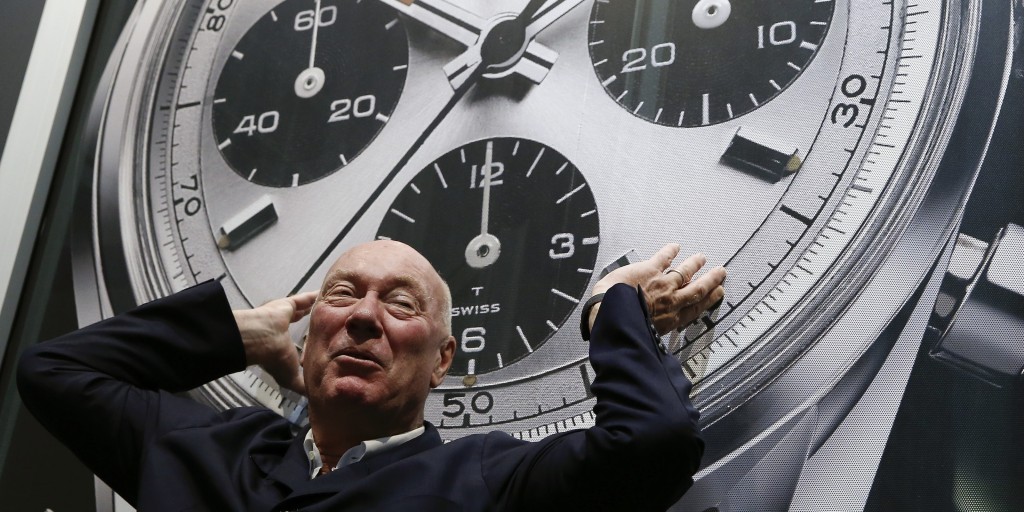Tag Heuer’s new gateway drug is the smartwatch (and its dealer is chief Jean-Claude Biver).
“The world is in trouble,” Jean-Claude Biver growled, ruddy-cheeked and fleshy-jowled, to The Business of Fashion’s Robin Swithinbank. “Syria is in trouble; the refugees are in trouble; Putin is in trouble; Ukraine is in trouble; Brexit is in trouble. . . . Goddamn, the whole world is in trouble! And we? We should sell watches like crazy!”
The time to buy, the saying goes, is when there’s blood running in the streets. And at Tag Heuer, chief Jean-Claude Biver, also the head of LVMH’s watch division, seems to have taken this maxim to heart. The world is in despair, experiencing a turbulent time indeed, and amid the chaos and fog, he sees a remarkable opportunity.

In March 2016, the BoF dispatched Ms. Swithinbank to the Baselworld watch expo where she met Mr. Biver at the “top floor of Hublot’s shiny black Baselworld stand.” In his ever-theatrical fashion, he explained Tag Heuer’s more approachable makeover, and tackled the brand’s heavy flirtation with smartwatches.
In reintroducing a newer, more approachable Tag imprint, he’s slashed prices at the 156-year-old Swiss outfit, and revamped Tag Heuer for the younger, entry-level luxury consumer. Considering the firm’s struggles over the last decade to gain footing in the ultra high-end market, and with the Swiss watch industry’s, and thus, Tag Heuer’s, ongoing struggles in China (due to over-leveraging the market’s immature luxury economy), one might view this as a smart move.
And Mr. Biver, of course, is the man to do it. He is viewed as something of a paterfamilias in the Swiss watch world, with an outstanding track record of successfully repositioning prestigious watch firms stretching back to the early 1980s. In 1982, he helped revive the once dormant Blancpain, guiding it to annual revenues of over 50 million Swiss Francs a decade later in 1992, before flipping it to Swatch Group that year. Since then, he’s helmed Omega, and has remade, for better or worse, LVMH’s Hublot into the gaudy label we find it today — much to the delight of LVMH CEO Bernard Arnault, who was so elated that he installed Mr. Biver the president of the French conglomerate’s entire watch division in 2014.
Tag’s new positioning now places the firm squarely in Apple’s sights, both in pricing and in product. The new Tag Heuer Connected, the brand’s first entry in the smartwatch category, first released in November 2015, appears to be the first of more coming, Mr. Biver hinted to BoF. And if that were true, it may not be a stretch to now look at Tag as LVMH’s hedge in the yet unsettled smartwatch category — and against the Apple Watch in particular.
Though logical, it begs the justifiable question of whether or not this is a smart long term move for the company. At the very least, one could certainly argue that Mr. Biver’s decision to send Tag downmarket is another tally for the “never stray from your core competency” argument. Had Tag never lost sight of their core consumer, had it avoided overextending its reach by over-investing in China, and had the firm avoided trying to compete at the super-premium level of the market for a decade, Tag would never have had to make this tactical adjustment.
The brand’s legacy, in fact, is that of a sports-driven luxury watch, akin to Omega, but with a deeper history in motorsports and yachting. This is where the brand should have dug in and held formation over in recent years. It could have perhaps dipped a toe in China, instead of a deep dive, and it could have realized that competing at the gilded end of the market with the likes of Patek Philippe or A. Lange & Sohne was a game they were never going to win.
That said, it may come as a surprise to learn that Tag’s move to smartwatches gets a nod of approval from the publication. Unlike other operators, Tag views the smartwatch as a means to an end — not an end in itself, which Mr. Biver makes rather clear. The company is not holding the new Connected model or any additional editions that may come, as the epoch of a new era, or a new idol in its lineup to be fawned over.
Far from it. The smartwatch is the gateway drug, in Mr. Biver’s opinion, to the longstanding, resilient mechanical watch. He’s positioned Tag Heuer, then, as the resourceful, congenial, dealer. “If you have never worn a watch, the effort to wear a watch is much bigger than if you have been wearing an information tool on the wrist since you were 15 years old,” Mr. Biver told Ms. Swithinbank. “The Connected watch is the best promotional tool for the mechanical watch.”
And here’s the kicker: Connected watch owners can switch out their Connected model for its mechanical equivalent after two years — making that transition from gateway drug to something more potent (and more expensive), as easy and convenient as possible.






